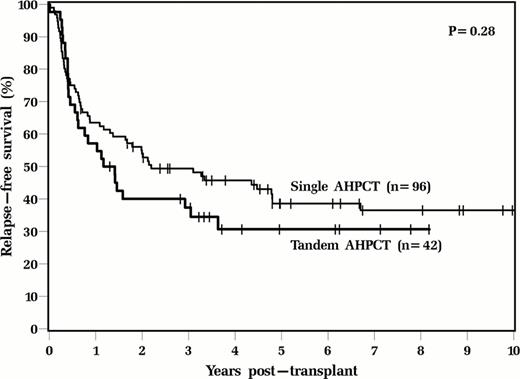Abstract
The efficacy of high-dose chemotherapy (HDC) and AHPCT is inferior for Hodgkin lymphoma patients (pts) with high-risk features, commonly defined as primary induction failure (PIF) or early relapse (within 1 year of achieving remission). Phase II studies have suggested that tandem courses of HDC with AHPCT may improve transplant outcomes. We therefore evaluated this approach in a single-center, prospective, phase II study. The primary endpoint of the trial was relapse-free survival (RFS). The intention-to-treat (ITT) analysis included 42 subjects with PIF or early relapse (within 1 year) who signed consent, of whom 37 underwent both transplants in 2002–2010 (3 were denied insurance coverage for tandem AHPCT, 1 had inadequate HPC harvest, and 1 withdrew). These subjects were compared retrospectively with 96 control pts who met eligibility criteria for the trial and underwent a single AHPCT from 1995–2009. HPC mobilization was with etoposide/filgrastim in all tandem AHPCT subjects, and in 55% of controls. Tandem pts received melphalan 150 mg/m2 with AHPCT. After a median of 52 days, tandem pts then received CBV (N=30) or busulfan, etoposide, and cyclophosphamide (BuCyVP; N=7, due to carmustine shortage) with AHPCT. Controls received BuCyVP (N=95) or CBV (N=1) with AHPCT. There were no clinically significant baseline differences between the tandem and control groups.
With a median 54 months follow-up at the time of analysis among tandem AHPCT survivors, 23 tandem pts and 47 controls were alive at the time of analysis. Causes of death among tandem AHPCT recipients included relapse (N=13), pulmonary (N=1), secondary malignancy (N=3), other (N=2). For controls, causes of death included relapse (N=37), pulmonary (N=2), secondary malignancy (N=2), other (N=8). Among tandem pts who received both transplants, 100-day mortality did not occur; there were 7 deaths within 100 days post AHPCT among controls (P=0.09). Median RFS was 15.5 months for tandem pts and 26.3 months for controls (P=0.28). Median overall survival (OS) was 54.9 months for tandem pts vs. 73.1 months for controls (P=0.76).
In multivariable analysis, factors associated with survival included race (non-Caucasian vs. Caucasian, HR 2.68, 95% CI 1.30–5.54, P=0.008), extent of prior chemotherapy (per 1 regimen increase, HR 2.54, 95% CI 1.71–3.77, P<0.001), and disease bulk (>10 cm vs. < 10 cm, HR 2.76, 95% CI 1.57–4.84, P<0.001). For RFS, prognostic factors included extent of prior chemotherapy (HR 2.15, 95% CI 1.47–3.13, P<0.001), disease bulk (HR 1.89, 95% CI 1.14–3.15, P=0.014), and disease status at transplant (relapsed/refractory vs. CR/PR, HR 1.91, 95% CI 1.14–3.20, P=0.014).
In conclusion, tandem AHPCT provides no demonstrable advantage over a single course of HDC with AHPCT in our analysis. More effective treatments are needed for pts with high-risk Hodgkin lymphoma, particularly ethnic minorities or those with bulky disease at transplant. Transplant outcomes suffered with additional lines of therapy before AHPCT, as shown in other published studies; thus, AHPCT should be prioritized over other interventions whenever feasible, at the time of induction failure or first relapse.
No relevant conflicts of interest to declare.

This icon denotes a clinically relevant abstract
Author notes
Asterisk with author names denotes non-ASH members.



This feature is available to Subscribers Only
Sign In or Create an Account Close Modal